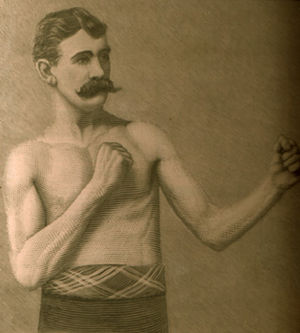(William “Shadow” Maber; via)
Trying to nail down traits of the typical “old timey” boxing character seems easy enough: funny stance, some type of sash, badly-fitting trousers and an epic mustache. To plant the stereotype’s roots deeper still, add a dash of jail time to a pinch of bar fighting hooligan and you have the “American Dream” of the turn of the century.
Australian character William “Shadow” Maber, who was the grandson of a pair of Irish and English convicts, calloused his knuckles in mining camps and small stake private bouts before making the sport his thing.
Taken in by “Smiler” Hales, editor of the Sydney paper the Referee, Maber was something of a prospect, years before the concept really existed. The Los Angeles Herald reported that Hales had said in 1892, “…as I have always predicted in the Referee, I will yet bring Maber out champion light weight of the world. I know this is a big boast, but I do not know a man on earth who has his advantages who can fight strong at 9 stone 7 pounds. When we cut for the championship you can bet all the bad whisky in Australia (and that is a big bet) that he’ll not give away a pound to any man, though at present Maber will meet a lot of these fellows up to 140 pounds.”
*******
Dubbed “The St. Paul Terror,” Danny Needham was likely no stranger to fighting around industrial parts of town, as St. Paul had plenty of railroad yards to trade strikes in, avoiding police or thieves in the process. But he had plenty of experience — amateur and professional — on Maber, entering the bout with over 50 verifiable fights on his ledger, in addition to potentially countless others he’d gotten into as a pickpocket.
The late February bout was initially signed for almost one month earlier and a $1,250 purse, but after a postponement, the purse was bumped to $1,550 at the Butte Athletic Club in Butte, Mont. Per the Denver Rocky Mountain News, Needham trained in Boulder Springs, Colo. for the fight, and both men had camps that lasted roughly six weeks.
The Australasian, a paper in Melbourne, said the bout was “a very obstinate one,” as it dragged on for over two hours, and went without much action for stretches. Needham applied the pressure from the outset, sending Maber down with a left hand in round 2, and again with another left in the 17th. The Kansas City Star called the next handful of rounds “devoid of incident,” but Needham was pegged by a series of uppercuts that had him hanging on in round 24. The 25th stanza saw both men exchanging punches as if the fight had just started, which led to Maber again hitting the deck in the 27th. And the Kansas City Star said, “[Maber] possessed a faculty for delivering hard blows on the breakway, and in this manner he made it unpleasant for his opponent.”
A right hand downstairs followed by an uppercut had Needham down and rocked badly in round 30, but the bell saved him, and he was able to seize momentum briefly in the following round with blind rushes — even closing Maber’s left eye with a right hand. A combination stole Needham’s legs and knocked him down once more in the 32nd round, where he was again saved by the gong.
Just a few days earlier, on February 24, 1893 in San Francisco, Dal Hawkins scored a KO in 15 rounds over William “Swede” Miller that robbed the latter of breath, ruled by “concussion to the brain.”
In the 33rd round, Maber scored three more knockdowns, and the 34th round had Needham’s lip splitting wide open to compliment a left eye that had swollen nearly shut. For the last time, Needham found the energy to fight back, and he went down from lack of steam and was counted out not long before the bell. It was at this moment, the Oregonian reported, that referee Duncan McDonald said, “I do not want a repetition of the recent California fight here, so I give this fight to Maber. Needham is too game a man to be thus punished.”
The crowd of over 2,000 people approved.
“Nonpareil” Jack Dempsey would call out Maber through the press for a few weeks after the bout, challenging him for a $3,000 purse. The fight never came through, however, and Dempsey fought only twice more over the following two years before retiring.
Maber fought for five more years, taking on names like Kid McCoy, Tommy Ryan, Tommy West and Young Griffo. But he spent his years after boxing in a way that seemed to mirror that of another troublemaker, Martin “Fiddler” Neary, and about the only way he could: with a mixture of jail, alcohol and the occasional job.

